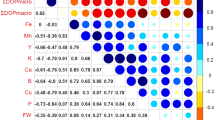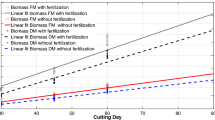Abstract
The marketable and nutritional quality of crisphead lettuce as affected by nitrogen supply, cultivar, and plant age at harvest was investigated in six plantings during 1989 and 1990. The optimum yield of marketable heads was obtained at a total nitrogen supply of 150 kg N per ha although only small differences were observed to the yield at 100 and 200 kg total N per ha. The total nitrogen supply included the amount of mineral nitrogen within the rhizosphere. The incidence of dry tipburn in older leaves was clearly decreased by an increased nitrogen supply, especially at late planting. The content of nitrate was increased and the content of dry matter and vitamin C decreased with increased nitrogen supply. The vitamin C content was higher for the cultivar ‘Marius’ than for ‘Saladin’. As plants got older, the nutritional quality of crisphead lettuce decreased because the content of nutrients, especially vitamin C, decreased with increased plant age at harvest.
Similar content being viewed by others
References
Wehrmann J, Scharpf H.C. (1979) Der Mineralstickstoffgehalt des Bodens als Maßstab für den Stickstoffdüngerbedarf (Nmin-Methode). Plant Soil 52: 109–126.
Hähndel R, Wehrmann J (1986) Einfluß der NO3-bzw. NH4-Ernährung auf Ertrag und Nitratgehalt von Spinat und Kopfsalat. Z Pflanzenernäh Bodenkd 149: 290–302.
Van der Boon J, Pieters JH, Slangen JHG, Titulaer HHH (1986) The effect of nitrogen fertilization on nitrate accumulation and yield of some field vegetables. In Lambers H, Neeteson JJ, Stulen I (eds), Fundamental, ecological and agricultural aspects of nitrogen metabolism in higher plants. Dordrecht/Boston/Lancaster: Martinus Nijhoff Publishers, pp. 489–492.
Collier GF, Tibbitts TW (1982) Tipburn of lettuce. Hort Rev 4: 49–56.
Barta DJ, Tibbitts TW (1986) Effects of artificial enclosure of young lettuce leaves on tipburn incidence and leaf calcium concentration. J Am Soc Hort Sci 111: 413–416.
Collier GF, Tibbitts TW (1984) Effect of relative humidity and root temperature on calcium concentration and tipburn development in lettuce. J Am Soc Hort Sci 109: 128–131.
Thibodeau PO, Minotti PL (1969) The influence of calcium on the development of lettuce tipburn. J Am Soc Hort Sci 94: 372–376.
Ashkar SA, Ries SK (1971) Lettuce tipburn as related to nutrient imbalance and nitrogen composition. J Am Soc Hort 96: 448–452.
Henriksen K (1978) Vanding af salat på friland. Nordisk Jordbrugsforskning 60: 603 (in Danish).
Termohlen GP, Van der Hoeven AP (1966) Tipburn symptoms in lettuce. Acta Hort 4: 105–108.
Feigin A, Pressman E, Imas P, Miltau O (1991) Combined effects of KNO3 and salinity on yield and chemical composition of lettuce and Chinese cabbage. Irrig Sci 12: 223–230.
Anonymous (n.d.) Shimadzu HIC-6A ion chromatograph instruction manual and ion chromatography guide. Kyoto, Japan: Shimadzu Corporation, 14 pp.
Anonymous (1985) Carbohydrate analyses by GC and HPLC. Supelco Inc., Bellemonte, PA: GC/HPLC Bulletin 774C, 6 pp.
Lento HG, Daugherty CE, Denton AE (1963) Polarographic determination of total ascorbic acid in foods. J Agric Food Chem 11: 22–26.
Pongracz G (1971) Neue Potentiometrische Bestimmungsmetode für Ascorbinsäure und deren Verbindungen. Z Anal Chem 253: 271–274.
Anonymous (1987) Manual for Kjeltec acid 1030 Analyzer. Tecator, Sweden, 60 pp.
Asp NG, Johansson CG, Siljeström M (1982) A rapid enzymatic method for assay of insoluble and soluble dietary fiber. 5. Joint CIQ/DGQ Congress Proc, pp. 41–67.
Everett PH (1980) Influence of fertilizer rates and plastic mulch on the production of two cultivars of crisphead lettuce. Proc Fla State Hort Soc 93: 243–245.
Walworth JL, Carling DE, Michaelson GJ (1992) Nitrogen sources and rates for direct-seeded and transplated head lettuce. HortScience 27: 228–230.
Wurr DCE, Fellows JR (1985) The effect of amount and timing of nitrogen application to drilled crisp lettuce crops on head weight at maturity. J Agric Sci, Cambridge 105: 727–729.
Palzkill DA, Tibbitts TW, Williams PH (1976) Enhancement of calcium transport to inner leaves of cabbage for prevention of tipburn. J Am Soc Hort Sci 101: 645–648.
Tibbitts TW, Palzkill DA (1979) Requirement for root-pressure flow to provide adequate calcium to low-transpiring tissue. Commun Soil Sci Plant Anal 10: 251–257.
Wiebe HJ, Schätzler HP, Kühn W (1977) On the movement and distribution of calcium in white cabbage in dependence of the water status. Plant Soil 48: 409–416.
Rosen CJ (1990) Leaf tipburn in cauliflower as affected by cultivar, calcium sprays, and nitrogen nutrition. HortScience 25: 660–663.
Nieuwhof M, Garretsen F, Wiering D (1960) Internal tipburn in white cabbage, II: The effect of some environmental factors. Euphytica 9: 275–280.
Peck NH (1981) Cabbage plant responce to nitrogen fertilization. Agron J 73: 679–684.
Peck NH, Dickson MH, MacDonald GE (1983) Tipburn susceptibility in semi-isogenic inbred lines of cabbage as influenced by nitrogen. HortScience 18: 726–28.
Greenwood DJ, Hunt J (1986) Effect of nitrogen fertiliser on the nitrate content of field vegetables grown in Britain. J Sci Food Agric 37: 373–383.
Hansen H (1978) The content of nitrate and protein in lettuce (Lactuca sativa var.capitata (Butterhead salad)) grown under different conditions. Qual Plant — Plant Foods Hum Nutr 28: 11–17.
Shinohara Y, Suzuki Y (1981) Effects of light and nutritional conditions on the ascorbic acid content of lettuce. J Japan Soc Hort Sci 50: 239–246.
Behr U, Wiebe HJ (1988) Beziehungen zwischen dem Gehalt an Nitrat und anderen Osmotica des Zellsaftes bei Kopfsalatsorten (Lactuca sativa L.). Gartenbauwissenschaft 53: 206–210.
Blom-Zandstra M, Lampe JEM (1985) The role of nitrate in the osmoregulation of lettuce (Lactuca sativa L.) grown at different light intensities. J Exp Bot 36: 1043–1052.
Danek-Jezik K (1986) Nitratvergleiche bei Treibsalatsorten in verschiedenen Entwicklungsstadien. Gartenbauwissenschaft 51: 190–192.
Bakker MJ, Slangen JHG, Glas W (1984) Comparative investigation into the effect of fertigation and broadcast fertilization on the yield and nitrate content of lettuce (Lactuca sativa L.). Neth J Agric Sci 32: 330–333.
Author information
Authors and Affiliations
Rights and permissions
About this article
Cite this article
Sørensen, J.N., Johansen, A.S. & Poulsen, N. Influence of growth conditions on the value of crisphead lettuce. Plant Food Hum Nutr 46, 1–11 (1994). https://doi.org/10.1007/BF01088455
Received:
Accepted:
Issue Date:
DOI: https://doi.org/10.1007/BF01088455




